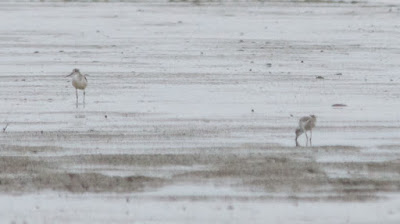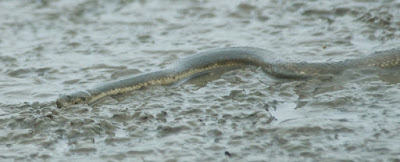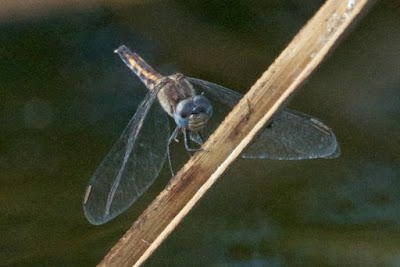January 2014 found Eileen and I on our way back to Malaysia. Before heading to Kuching, though, we took a detour to the island of Penang with our cousins Chris and Susan Chang. Penang, of course, is a place one goes to more for food (and boy, did we eat!) than for nature. However, Penang is also the home of crack birder David Bakewell. On January 11, Dave was kind enough to whisk me off for a day's birding on the adjacent mainland. Our day was a considerable success (and probably provided me with a necessary calorie break). Dave, who is much less tardy at blog-writing than I am, has already posted a detailed account on his excellent blog; here's my side of the story.

Dave is an expert at shorebird identification, and the west coast of Peninsular Malaysia is one of the best places to see two of the rarest shorebirds in the world on their wintering grounds. My first request, therefore, was that we should try to find the Asian, or Asiatic, Dowitcher (Limnodromus semipalmatus) and Nordmann's Greenshank (Tringa guttifer), birds I had long wanted to see. For that, we had to go to a muddy stretch of coastline opposite the city of Georgetown, part of the Teluk Air Tawar-Kuala Muda Important Bird Area.
The tide conditions were not, alas, ideal, and the birds were a long way off....
...but they were there, and fortunately Dave had a telescope.
Even at a great distance, it was possible to identify birds - especially the ones that weren't shorebirds. Notice the Brahminy Kite (Haliastur indus) in the bottom photo.
Other non-shorebirds included a few Brown-headed Gulls (Chroicocephalus brunnicephalus).
Pond herons were about as well. Although identifying the three Asian species in non-breeding plumage is all but impossible, this one (holding what seems to be a quite substantial catch) is most likey to be a Chinese Pond Heron (Ardeola bacchus).
The shorebirds that came close to us were mostly Common Redshanks (Tringa totanus), which seemed to prefer to huddle at the upper tide line.
The really nifty birds stayed well out of reach, at least for me if not for Dave (who combines better photographic skills than mine with a howitzer-length telephoto; you really should read his account). Nonetheless, we did see four Asian Dowitchers (the lower photo was snapped with an iPhone through Dave's spotting scope) at what Dave call's "reasonable range". Well, I could tell what they were. The Asian Dowitcher is a considerably bigger and more godwit-like bird than the two dowitchers we see in North America, with a long, relatively heavy bill. It feeds in a typically dowitcher-like "sewing-machine" fashion; Dave's account has a nice video that shows this very well.

We saw Nordmann's Greenshanks as well, but even further out. However, even at this distance we were able to see the bird's two chief distinguishing marks: shorter legs, and a more sharply bicoloured bill, than in its nearest (and far commoner) relative the Common Greenshank (Tringa nebularia). So tally ho, even from a long way off!
There were things to see nearer to the tideline, but they were, mostly, not birds. Fiddler crabs scuttled over the mudflats...
... joined by mudskippers of (presumably) various species. This is the common Blue-spotted mudskipper (Boleophthalmus boddarti).
In pursuit of the crabs (and the mudskippers) was a Dog-faced Watersnake (Cerberus rynchops), a reptile that does much better on brackish mudflats than on land. It apparently pursues mudskippers into their burrows, and even (so they say) baits small fishes with its tail.
An assortment of shells littered the upper tide line, mostly (at least in this photograph) the remains of ark clams (Family Arcidae). Arcids are usually known as cockles in Malaysia, but true cockles belong to a different family, Cardiidae.
This strange object clinging to a stone gave me some pause, but it appears to be an onch slug (Family Onchidiidae). Onchidiids, though they live in (or by) the sea and lack shells, are not sea slugs but air-breathing relatives of the snails one finds in gardens. You can see this one's antennae protruding from beneath its mantle at the bottom of the photograph.
At length the birds decided to move on, flying up against the urban background of Penang Island, and we decided to do the same.
Our next stop was a patch of reeds, home to what may be Malaysia's most recent avian arrival. The Manchurian Reed Warbler (Acrocephalus tangorum) is a local and declining species, only recently split from the Paddyfield Warbler (A. agricola). It has not made it onto the official Malaysian list yet, but it has now been found wintering at two sites on the Peninsula. I failed to get a photo of it, so again I'll have to refer you to Dave - but at least I saw it, which is more than I can say for the persistently-calling, but invisible, Pallas's Grasshopper Warblers (Locustella certhiola) at the same site.
I had better luck with this fine Eastern Imperial Eagle (Aquila heliaca), a bird I had only seen previously at the other end of its range, in the Tatra Mountains of Slovakia.
This Brown Shrike (Lanius cristatus), photographed along the roadside on the way to our next stop, was considerably more cooperative.
Other roadside creatures included an Oriental Garden Lizard (Calotes versicolor), common here but a species I do not see in Sarawak (though I gather it has been introduced to Brunei).
Brachythemis contaminata is a common dragonfly on the Malay Peninsula and Singapore, but it is another species apparently absent from Borneo. It tolerates polluted waters (as Dave pointed out, its specific name contaminata reflects its tastes in habitat, and it is commonly known as the Ditch Jewel).
This is a female.
This tiny Agriocnemis femina, an immature male, turned up in a men's washroom stall. As I don't normally carry my camera gear into the toilet I had to make do with my iPhone - and the fact that the result is identifiable I put down to pure serendipity.
One of the more optimistic things a naturalist can do in South Florida is to discover areas that, counter to the usual tendency for urban and suburban sprawl, are being converted from manicured lawns and sterile pools back into natural areas. I first came across the Pondhawk Natural Area in northern Boca Raton, a 79-acre site adjacent to the Spanish River Public Library (and sharing its parking lot), in November 2013. Naturally, a site named after a dragonfly had a particular attraction for me, and I paid the area several visits during that month and the next.
Pondhawk centers around a restored marshy area and a scrub zone dotted with pine, underlain with a dense growth of Saw Palmetto (Serenoa repens) and containing some of the largest Pond Apple (Annona glabra) trees in the state.
It is still being restored, and much of it has only recently been replanted with native vegetation.
A paved path through the area provides a good vantage point for watching wildlife...
...and an observation platform over the marsh provides, when the water is high (it isn't always, unfortunately), an excellent platform for photographing dragonflies in flight.
To get to the trail, you cross a bridge over a pond that is still very much a manicured, human creation. There are nearly always a few Muscovy Ducks (Cairina moschata) poking around the edge. These are the descendants of farmyard birds, with lots of white in their plumage, though this one, except for its face, comes closer to the wild birds you might see in tropical America.
I am never quite sure whether the Salvia flowers that bloom along the beginning of the path are garden escapees or genuine wild flowers, though the bright red Tropical Sage (Salvia coccinea) cetrainly grows naturally in South Florida.
The further you go, the more obviously natural the vegetation becomes. American Beautyberry (Callicarpa americana) is a particularly gorgeous example, though it, too, is often planted as an ornamental. Its colourful fruits are popular with a wide range of birds (you can make jelly from them, too).
Pondhawk is not an outstanding bird spot, though I did think that these female Red-winged Blackbirds (Agelaius phoeniceus) made a nice grouping.
It's a lot better for reptiles (though they will have to wait for another time) and insects, including this White Peacock (Anartia jatrophae).
As its name promises, Pondhawk can be very good for dragonflies and damselflies. I found plenty of Atlantic Bluets (Enallagma doubledayi) along the path - Enallagma bluets are the devil to identify, but in South Florida there are far fewer possibilities than at home in Ontario and I can identify these males with some confidence.
The widespread Rambur's Forktail (Ischnura ramburii) is the damselfly I see most often in South Florida. It ranges throughout the southern United States and the West Indies to Venezuela and southern California.
Here is a pair of mating Rambur's Forktails 'in wheel'.
Among the more easily identifiable of the smaller dragonflies is the male Band-winged Dragonlet (Erythrodiplax umbrata), with its long, narrow, cross-barred wings. In eastern North America this is a South Florida specialty, though it is more widespread in the American southwest and ranges south to Argentina. It apparently migrates, sometimes by the millions.
The female is less obvious, and behaves rather differently. Though the males were common enough around the water's edge, I only saw females perched over the path in its more densely-wooded stretches.
I at first took this for the common Blue Dasher (Pachydiplax longipennis), but it was smaller, with duller blue (not green) eyes and no orange on the underside of the thorax. It was, instead, a male Little Blue Dragonlet (Erythrodiplax miniscula). This is a dragonfly that perches low in the pondside vegetation, and is easy to overlook.
This is the female; notice the distinctive dark stripe along the top of the abdomen.
The rather mottled pattern along the side of the thorax reveals this as a female Roseate Skimmer (Orthemis ferruginea). Oddly, I did not see any of the reddish-purple males.
One of the more striking dragonflies at Pondhawk was the Carolina Saddlebags (Tramea carolina), one of a group of dragonflies named for the saddlebag-shaped dark patches on the hindwings.
Saddlebags spend a lot of time on the wing, but when perched I found them quite easy to approach.
The Vermilion Saddlebags (Tramea abdominalis) is a widespread Central and South American dragonfly that reaches extreme southern Florida. The lower photo shows that its "saddlebags" are much narrower than those on the Carolina. The Vermilion Saddlebags can be told from two other very similar South Florida species, the Antillean Saddlebags (T. insularis) and the Striped Saddlebags (T. calverti), by its combination of a red face and black spots on the top of s8, its eighth abdominal segment (the Antillean has a brown face, and in the Striped s8 is almost entirely black).
Here are head-on views of the Carolina and Vermilion Saddlebags in flight. Even if you can't see the saddlebag markings, the red face of the Vermilion (lower photo) distinguishes it from the Carolina.
Though both saddlebags were new to me, I was probably most chuffed about my trips to Pondhawk by my encounters with the Common Green Darner (Anax junius). This is a widespread species (it even shows up in my garden at home) but, like most darners, it rarely holds still. Most of my photographs of it have been less than impressive. Not this time.
These were taken from the observation platform over the pond on November 19, 2013. The pond was full of water, and the darners were hovering just below me (my saddlebag flight shots are from the same spot). For once, I could get them in focus, in good light and against a dark background, and reveal what beautiful insects they are.
My delight at getting these shots is the reason I am sharing so many of them with you. I hope you don't mind, but I find these images a lovely way to bring my account of our travels in 2013, at long last (and very late), to an end.
























































































